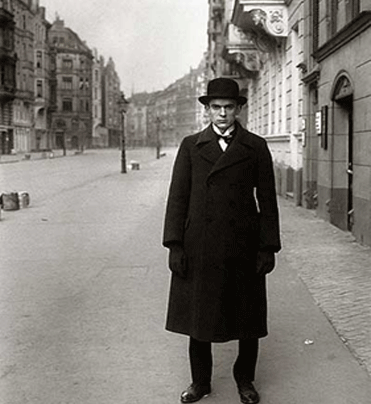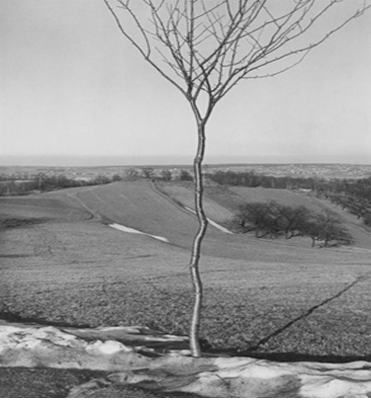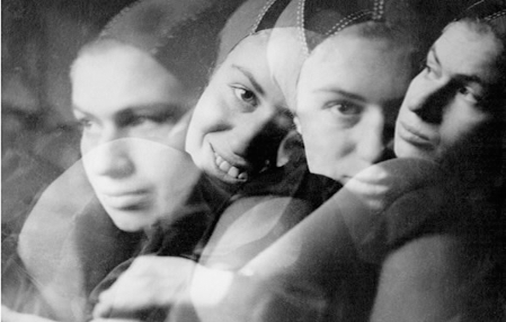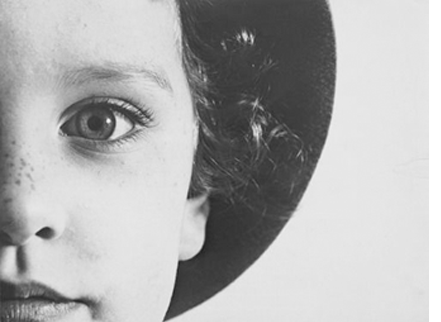Hildegard Baum and Alice Brill, development and awakening
of sensitivity: Between the Forefront and the Shadows
Yara Schreiber Dines
Abstract
The article addresses the training and development of Hildegard Baum and Alice Brill, in Germany at the beginning of the 20th century. The two future artists grew up in a country undergoing political and social crisis, presenting a transitional scenario from the Weimar Republic to the beginning of Nazism. The prevailing political climate is exposed, as well as aspects regarding the social situation of women at the time in the country, in order to provide an evaluation of the values and mentality in effect with regard to the gender issue. A panorama of the artistic context present in Germany is also introduced, with visual culture characteristics that influence its formation, repertoire and perspective. The article is concluded with comments on the exile of both artists in São Paulo/Brazil and their manner of professional and artistic insertion in the city as female photographers.
Prologue
Two girls are born in Europe, in Switzerland and Germany respectively – between 1910 and 1920 – and live through a turbulent period. They grow up in Germany, after the first World War, within a context of a hangover, grief and bitterness, with the country’s surrender and loss of the armistice. On the other hand, they also live within the prevailing Weimar Republic and the artistic forefront of this country, which expresses and manifests itself intensely during this period, bringing new airs and possibilities to the German people, albeit briefly.
This is the social and political scenario we find at the time when Hildegard Baum (after getting married, Rosenthal) and Alice Brill are born. They become photographers, female artists, and their work in modern photography is the object of this study. This article develops aspects about the formation and cultural influences of these girls, who grow up under this weight and a tense cultural climate, enhanced with the emergence of the shadow of Nazism in Germany.
Eric Dunning and Stephen Mennell, in the preface of the book, The Germans – Power Struggles and the Development of Habitus in the Nineteenth and Twentieth Centuries (1997), suggest that the author Norbert Elias “describes Germany’s Second Empire - the unified Kaiserreich from 1873-1918 - as a satisfaktionsfahige Geselschaft, an expression impossible to translate directly, which means a society gravitating around an honour code where duelling, demanding and satisfying claims were arrogantly highlighted.” For Elias, the unification of Germany therefore, involved the ‘brutalization’ of vast sectors in the middle classes.
In the work, Elias studies the weakening of state control in Germany, after World War I, and in this context military brigades of volunteers Freikorps were formed, also with student fraternities in the universities, undermining the Weimar Republic and leading to a violent movement against Weimer parliamentary debate and seeking the creation of an authoritarian government.
In 1918, after losing the war and a succession of labour riots, the abdication of Wilhelm II takes place, establishing a Parliamentary Republic in Germany. The social-democrats, previously left-wing, seize power, crushing the socialist revolution and enacting the Constitution, in November 1919. The Weimar Republic emerges in these conditions, and was so called because the Constitution was signed in Weimar, city of Saxony. The difficult economic scenario gets worse with the political propositions of the countries that had won the war. According to Daniela Alarcon (2008:26):
“After the armistice, follows the Treaty of Versailles, from 1919, which imposed the loss of territories, reduction of the army contingent and the production of military equipment became forbidden in Germany, as well as other punishments. Inflation rose intensely and social unrest with it.”
For Hobsbawn (2001), the main argument of the treaty came from the ‘guilty of war’ clause, which morally punished Germany for the consequences generated by the conflict. Thus, besides punitive political and economic measures, the country suffered intense symbolic damage.
According to Elias (1988), in the book quoted, losing World War I was unexpected and very traumatic. It touched a sensitive node in the ‘habitus nacional’ and was experimented as a return to the period of German weakness, when foreign forces were in the country, a period in the shadow of a more vigorous past. The German recovery movement was suspended. Many people from middle and high classes in Germany, possibly most of them, considered they would not be able to stand the humiliation. Therefore, they believed it was necessary to prepare for the next war, with better possibility of victory for Germany, although in the beginning they had no idea how this could be achieved.
The word habitus, is used by Elias to mean ‘second nature’ or ‘incorporated social knowledge’. The author uses this definition well before its dissemination by Pierre Bourdieu. The notion is widely used in the sense of overcoming issues such as the concept of a ‘national character’, seen as fixed and permanent. This idea means that “the destinies of a nation over the centuries become sedimented in the habitus of its individual members, and, consequently, the habitus changes over time precisely because of the fortunes and experiences of a nation (or its constituent clusters) that continue to change and accumulate.” (1988:8)
The Treaty of Versailles was signed on 28/06/1919. Germany lost Alsace-Lorraine and its African colonies. It was also forced to relinquish territories to Poland, Czechoslovakia, Belgium while Sartre remained under the League of the Nations. In contrast, military service was cancelled.
Regarding the writing of the constitution, there was strong debate about the democratization of the political and economic institutions, however the word democracy was not included in the text. Therefore, Germany was simply denominated as a Republic “whose political power arose from the people” (Lionel, 1988:54).
In the words of Richard Lionel, in The Weimar Republic, if, before the Republic, this city concentrated the greatest names in German culture, such as Goethe, Schiller, Bach and Liszt, “in the memory of the German people, Weimar was not a symbol of classic cultural inheritance anymore. Its recent fame tended to erase the rest. It was mainly due to the acceptance of peace with the conditions imposed by the allies than the voting of the constitution. In the spirits, it inevitably evoked the words ‘surrender’, ‘disgrace’, and ‘weakness’. Soon the remedying to be paid and the occupation of Ruhr by the French troupes, would feed this almost general feeling of unfair pillage. The nationalists, after the Nazis, would soon learn to remove the instigation of retaliation and war, once more.” (1988: 55).
According to the same author, the Weimar Republic was thus founded. It emerged from a suffocated revolution, a coalition created among the former prominent social classes under Wilhelm II, members of the imperial army and the leaders of the Social Democratic Party. Considering how it had been formed, it would be very difficult to prevent it from being crushed by the right-wing groups.
For Louis Dupeaux, in Study of German Cultural History (1992), cutting-edge action related to Germany, during this period, did not include the most relevant cultural expressions, classic culture still prevailed. For example, in visual arts, in parallel, to expressionism, most of the public continued to be faithful to the values reaffirmed in the German Historical Art Galleries.
In the thirties, Peter Gay (1978) states that “intellectuals and artists direct their distress towards creation: the forefront developed then was dramatically politicized. With the advent of the Republic, those who previously lent their critical sense against the government of Wilhelm II (1888-1918), associated to the evil of World War I, shifted their focus on the inherent contradictions to the new government, opening space for the rising of Nazism.” Peter Gay considers that the creation of the Weimar Republic intensified the intellectual and artistic weight of this generation.
Elias understands that Hitler’s rise to power and the Nazi genocides were necessarily a result of the structural arrangement of the German society, formed by the social, political, economic conditions and the mentality of the period. Also that the nationally stigmatizing process unfolded as a result of decisions made during a national crisis by groups having strong influence, which had great popular support, mainly the middle class and that acted in consequence of aspects intensely based on “habitus, personality, idiosyncrasy, social structure and German behaviour (1988: 8).”
This author also understood, with regard to the circumstance being studied, the anxiety to go back to a government with one “strong man”, widely rejected by parliamentary democracy; a greater political field of the ‘semi-educated’ group and, mainly, as the German people were morally attacked in the 1930s it allowed itself to be conducted and dominated by Hitler, a type of healer and political wizard, with the idyllic promise of realizing the old German dream of a European Reich, where Germans would take advantage of the prestige in integrating the so-called “Arian Master Race’ without great penalties.
At the time, Thomas Mann remarked on the prevailing social climate, stating that the “country seems to be singularly receptive to irrationalism, it is immersed in irrational jargon. Everywhere, he says, in 1929, there is the will to ‘re-establish’. In triumph, in its primitive vital right, the dark forces and those from abyssal depths, the instinctive, the irrational.” (apud Lionel, 1988: 246)
Thus, the fragile Weimar Republic, in Germany – that lasted practically until the economic crisis of 1929, in the United States, with the great depression generated worldwide – brought with it social instability. Therefore, the political history of this Republic is a theme marked by uncertainty.
Richard Lionel raises the following question about the social configuration in Germany, perceived at the end of the 1920s: “What do they want? An elite that truly exerts authority and not a Parliament and impotent parties; a Germany in charge of saving the white race and European civilizatijkon; a strong State.” (Lionel, 1988, 251)
Women in Germany, in the 1920s and 1930s
A panorama of the female social conditions is presented, in order to position the social context in which the Mothers of Alice Brill and Hildegard Baum - respectively Anni Baum and Marte Brill as well as the birth of their daughters – their ways of integrating, sociability and their life in society at the time being studied.
In the 1920s, the rule for women was to have a difficult life and they started claiming the right to freedom and making campaigns and manifestations against the repression of abortion. However, in a scenario of exceptions, new types of women such as ‘à la garçonne’ arose, athletic and with sexual freedom.
In 19/01/1919, four days after the murder of Rosa Luxemburg, within the context of the Weimar Republic emergence, German women voted for the first time. According to Richard Lionel, in Berlin 1919-1933 L'incarnation extrême de la modernité (1993), 90% of women voted.
Moreover, as stated by the author “to be a typist”: is the dream of all young women in the working class from Berlin – to enter the white collar class – and of the middle class women whose parents cannot pay their education at school or in high school”. (Lionel,1993: 95,96)
Lionel says:
“the short-hand writer, secretary, saleswoman embody the type of ‘new woman’ in Berlin. It is the woman that has cut off her plaits and now has hair ‘à la garçonne’ and her legs waxed. Aware of her value, materially independent, athletic, with sexual freedom’, she has the audacity to sit by herself in cafes and smoke in public.” (Lionel, 1993: 96)
Middle class women also visit their friend’s houses, during the war. The visits are like a party and ritual for the period, in an environment where they knit wool and friendship, or even talk over a cup of tea or coffee and some cake.
The educated women of Berlin meet their friends at the theater, or in literary halls. At this time, they also showed great enthusiasm for psychoanalysis and astrology.
Only 10% of the women study at university, and it is important to highlight that “none of the 10,595 German women, who obtain a PhD in any subject, between 1908 (date on which the law became effective that gives women access to higher education) and 1933, get to be head of a subject at university” (Lionel, 1993: 101). In this regard, “in 1933, less than 30% of married women worked, an unchanged rate since 1925.” (apud Alarcon, 2007:41)
In 1933, with the Nazi’s rise to power, family planning offices are destroyed and those responsible for them arrested. Many female workers also go back to doing only household chores, as conservatism prevails. Therefore, many women during this period say they did not have a profession, they only worked.
The Artistic and Photographic Scenario, at the end of the 1920s – The New Vision and The New Objectivity
Names of artists such as Bertold Brecht, Georges Grosz, Fritz Lang, Kurt Weil, among others, attracted attention and cultural debate in the artistic universe, at the end of the 1920s.
According to Lionel,
“in the months of revolutionary upheaval following… World War I, a creative activity movement started on an unprecedented scale all over Germany. All the pent-up passions exploded, all the artificial bonds were broken. The will to break up with the past, build something new, inflated most of the generation of poets and painters who had just ended their teenage years, were affected by the atrocities of war, Their ideal? Regenerate humanity, open the path to the ruling of a new man, a truly human man!” (Lionel, 1988: 255).
In contrast to the imperial period, several writers, painters, architects, musicians do not intend to work for the aesthetic pleasure of the dominating class.
“For them, artistic activities should be integrated into the set of social activities. These are especially the thoughts of Walter Gropius when he founds Bauhaus in 1919. Constructing he says, is not creating art, but life, giving shape to life.” (Lionel, 1988: 255)
In 1920, the right-wing parties obtain 46% of the votes. Rebel expectations begin to decline all over the country. There is very little left of the great collective movement, which many poets, playwrights, writers and artists had adhered to. Some magazines and groups were still active, however the utopic flow and passionate enthusiasm in favour of the change in humanity become subdued and diminish.
Expressions from films of the period such as ‘The cabinet of Dr. Caligari’, by Robert Wiene, ‘Nosferatu’, by Murnau, ‘Dr. Mabuse’, ‘The Gambler’, by Fritz Lang, silently show, through lighting and characters, the disorder at the beginning of the 1920s, with instincts that unfold and tyrants lurking around.
The scenario effectively changes as from 1925. The artistic tendencies are directed towards the social sphere, thus the search for something concrete is highlighted, in sociological research and news reports. After the phase of imagination and intuition, we have the re-entrance of ‘direct’, ‘pure’. “Paintings recover their sobriety, an almost naturalistic representation. Otto Dix, an expressionist writer and former Dadaist, that sympathizes with the Red Club, around George Grosz and John Heartfield, and then with the Association of Revolutionary Visual Artists later said: ‘Art, the expressionists had done too much. We wanted things to be seen bare, showing all evidence – almost without art.” (Lionel, 1988: 258)
The period between 1923 and 1929 was a dynamic period for modern photography in the Weimar Republic of Germany and Staatliches Bauhaus represented its more relevant forum, although it only introduced photography in 1929.
The New Objectivity, very relevant artistic trend at the time, had the objective of ‘concluding’, ‘narrating’, ‘reporting’. The search for what was concrete, a characteristic of the Weimar Republic, from 1925 to 1930, presents as a positive balance, calling attention to what were considered the minor arts. With emphasis being placed on illustrated magazines, typography, photography and photomontage become the main focus of interest and appreciation. Graphic arts reach the daily sphere, a privileged space, the following artists, coming from the painting universe, integrated this expansion: Hans Bellmer, John Heartfield, Lászlò Moholy-Nagy and Jan Tschichold.
Integrating the New Objectivity trend in the same period, photography reaches greater prominence. The enhancing of equipment and the taste of knowing the technique provide this attraction.
Lászlò Moholy Nagy was the main agent to make Bauhaus photography relevant. He understood that photography created an ideal visual language for the innovative demands of modern society.
According to the writer Richard Lionel, three main directions are revealed in photography – some are tempted by experimental photography, which needs to be invented and constructed, a true game of shapes. Moholy-Nagy, with his book Malerei Photography Film, from 1925, appears as a pioneer, formulating the aesthetics of the New Vision in this book. This trend also used uncommon forms of language such as frames and photomontages that mixed photography with modern typography.
The New Vision would occupy the foreground of the German photographic scenery during the end of the decade and reach its greatest climax in 1929 with a series of great exhibitions and publications that disclose the movement.
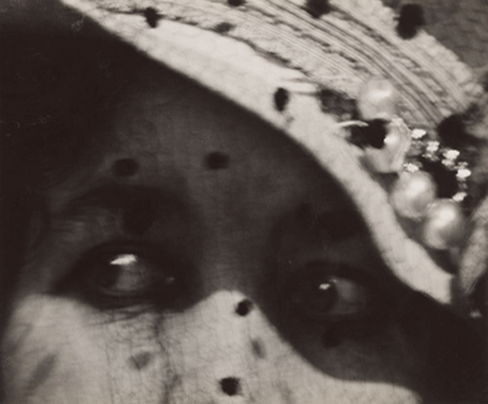
Max Burchartz, Grete´s eyes,1928 (New Vision)
On the other hand, the second direction of photography – social realism – characterizes the pictures of August Sander gathered in 1929, in Face of our Time (which later were inserted in People of the 20th Century, 2002), the same way as the movement of working photographers, animated by Hermann Leupold. Some, finally – third direction of photography -, intend to waiver any critical distance and disappear with regard to the object being photographed, to provide absolute authenticity: the outcome of this program was the album made by Albert Renger-Patzsch, The world is beautiful, 1928 and that of Hans Gunther, Technical Beauty, 1929 (1988:262).
August Sander, People of the 20th Century
For Juliet Hacking, organizer of the reference work Photography: The Whole Story (2012: 208), when commenting on modern photography from the Weimar Republic, she considers that:
“the conventional rules of photography were equally challenged, when photographers pointed the camera up or down, using diagonal lines or highlighting details, creating dramatic close-ups, aerial views of urban roads or landscapes that transformed common surfaces into geometric standards....”.
Albert Renger-Patzsch was as relevant as Moholy-Nagy at the time, the former is the precursor of the aesthetic proposal of New Objectivity, in photography. In principle, it was tried out by German painters, in the period between the wars as antagonism to expressionism. Renger-Patzsch understood that photography should concentrate on documenting reality, which he saw as the main role of the camera. The public should not be conditioned to the subjective look of the photographer and visually attractive composition schemes, the photographer should highlight the object registering it in realistic and subtle aspects. For such purpose the object was inserted in the center of a proportional frame with only the receptor/public being left to observe the theme itself.
Albert Renger Paztsch, A tree seedling, 1929
Moholy-Nagy and Renger-Patzsch presented their diverging proposals in the magazine Das Deutsche Lichtbild (German photography). Although it exposed important aesthetic differences, both had a lot in common, as they understood photography as a form of autonomous art and created ‘direct’ aesthetics, without manipulation of the picture, which became very relevant in the artistic world, at the time, and even afterwards for some photographers.
The importance of presenting these profiles in the currents of New Vision and New Objectivity must be emphasized, as they mark photography of the end of the 1920s and beginning of the following decade, in Germany. This aesthetic framework of photography brings references to language and artistic exponents, mainly in what refers to New Objectivity, which will influence the look and production of the two highlighted photographs.
The development/awakening[1] of Hildegard Baum and Alice Brill
The moment of awakening, according to Walter Benjamin, can be seen as an image, which creates a cut off line or an interval between things. This image is understood as dialectic, as it moves between presence and representation, between the changes and continuities. This metaphor for the awakening, elaborated by Benjamin interpreted by Didi-Huberman (2006), seemed very fruitful to think about education, the formation of sensitivity and the creative look of both girls, who would become artistic women.
Hildegard Baum
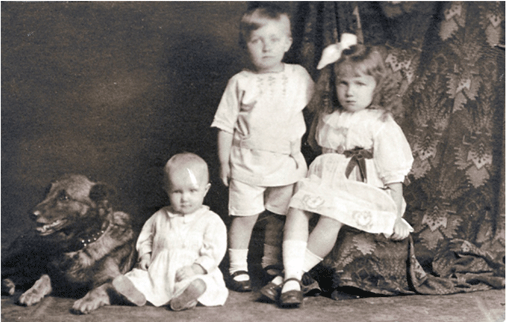
Lilly, Hans and Hildegard Baum, Frankfurt, c. 1917, Lilly Schneider’s private collection
Hildegard Baum was born in Zurich, in 1913, in Switzerland, but her parents were German. According to the testimony given by the photographer Juvenal Pereira (reported in the conversations with Verônica Rosenthal, daughter of Hildegard Rosenthal), the couple Anni and Ernst Baum, Hildegard’s parents (not married yet), went to Switzerland when she was 3 months pregnant, and had their daughter there returning to Frankfurt, with Hildegard, when she was 3 months old.
As reported in the testimonial, Anni hid her pregnancy, due to the morality of the period. On coming came back from Zurich she left Hildegard in the care of unmarried aunts, who were sisters of Ernst her husband, as the couple did not have financial conditions to take care of her.[2]
Ernst Baum’s Father had a hotel in the centre of Frankfurt, Hotel zum Hessenlaendch, and, in 1918, offered a room for Hildegard’s parents to stay in with their family, and they lived there until 1922. “The parents got married, when they found a job and straightened out their life” (notes made by the photographer Juvenal Pereira). They later had another three children - Hans, Lilly and Walter. Hildegard lived with her paternal grandfather until she was 6 and was raised by him and the unmarried aunts, during this period.
During her childhood, Hildegard Baum and her sister Lilly studied in a Protestant girls’ school - Katharinenschule - in Frankfurt. She always liked children, and as an adult specialized in pedagogy, in France.
In her youth, Hildegard Baum already walked around with a photographic camera. As from her testimonial in the Museum of Sound and Image, in 1981, the following excerpt was extracted, narrating her first picture, in which the following is highlighted:
“- One day, I say a very focused boy, a dreamer, a very intelligent boy, sensitive. He had huge black eyes and was daydreaming. I had a photographic camera, I don’t even know which one it was, I think it was a 6X9, and I was lucky enough to take a picture of the boy in a very extroverted pose. I gave the photograph to the parents and they sent it to Vienna, to a contest organized by a very famous newspaper, the Neue Ferie Press (currently Die Presse). I received 1st prize with this picture” (apud Gonçalves, 2007: 124), in the beginning of the 1930s.
From this date on, she became more interested in photography.
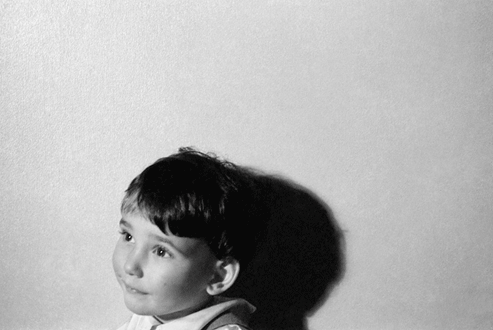
Hildegard Rosenthal, Picture of a Boy, Frankfurt, c. 1931, The Moreira Salles Institute Collection
As presented by the caption of the picture, this is a portrait. We see very few elements in the image, it is practically only the boy’s face, with his short hair, and projected shadow that was focused on and registered, as well as a glimpse of his shirt collar, which seems to be overlapping another blouse (or vest?) – deductions as from the trimming of the image. The picture of the young Hildegard shows her interest in children, which has been mentioned before, and later on, in her work in São Paulo, she will also take pictures of children from foreign families.
The image also exposes the framework - from above - an innovation, at the time of the New Vision current, at the end of the 1920s, where the focus is on a child that shows a very gentle, calm and sensitive look.
Due to the framework, the child seems to be looking up, as if he were drifting off, daydreaming says Hildegard Rosenthal, in her testimonial quoted above. If every picture is a projection of yourself, as in the opinion of Susan Sontag in About Photography (2004), possibly the young photographer when seeing the boy with the sensitive and dreamy expression, projected herself in the boy looking up and in the direction of the transformation.
It is also interesting to note that the type of picture, with the characteristics mentioned, presents the cultural influences of the period, having visual resonance with the actual look of New Vision, in the beginning of the 1930s, therefore it conquers first place in a photography contest, in the greatest newspaper of Vienna.
László Moholy-Nagy, Untitled (Multiple Portrait),
c. 1927, Folkwang Museum Collection, Essen (New Vision)
Max Burchartz, Lotte (eye), c. 1928 (New Vision)
These two images have been selected - portraits – respectively by Lászlo Moholy-Nagy and Max Bruchartz, participants of the New Vision trend, which show proposals of photographs from the period, such as the capturing of movement, as from low resolution registration, and also in the second photograph – a cut-out, a fragment of a face – that tries to transmit the idea of the whole. These images were taken at the end of the 1920s, creating a dialogue with that of the boy by Hildegard, from 1931.
At 18 years of age, Hildegard Baum enrolled in a photography course, offered by Paul Wolff, which lasted one year and a half. This photographer, was the first to use the Leica for several photographic jobs.
According to Paula Chrystina Scarpin Gonçalves, in her work Vale das Rosas. Hildegard Rosenthal – pioneer in photography in Brazil[3], “ the Leica, a portable 35 mm camera developed by Oscar Barmack and Maw Berek, began to be produced in 1923, by the Leitz Wetzlar Factory, however it was only sold as of 1925. The small apparatus was designed to use the same cinematographic film… The film allowed 36 exposures without recharging – a revolution for professional work”. (Gonçalves, 2007: 21)
In 1926, Paul Wolff participated in an international photography exhibition in Frankfurt and for the first time came into contact with the Leica. The course that Hildegard did with him was geared towards the practice of photography.
This photographer/professor had great influence in Hildegard’s work, initially by encouraging the use of the 35mm camera, that was the main professional companion in her life. He said to his students: “... the most important instrument for you, besides the Leica, is light...” (Gonçalves, 2007: 22)
It is relevant to emphasize that in the mid-1930s, most of the illustrated magazines did not allow the use of the Leica. Hildegard states in her testimonial to the Museum of Image and Sound (1981):
“Well, first, he had difficulty to convince people to get used to the 35 mm, because at the time it was still 13x18, 9x12, and to put into our heads that the rapid camera did not dismiss judgment, criteria, the study of the photograph...” (apud Gonçalves, 2007:141)
With regard to the practical classes of Paul Wolff’s course, Hildegard remarks the following in her testimonial:
“- We entered a Mercedes Benz and went around the world. Then he did something that was unusual too (...) He looked around the countryside of Germany, because this also exists, it’s not only the city… the fields, the peasants (...) we went out in groups and before going off, he made a great lecture every time, about each subject. You are going into a house, without warning... try to be polite.” (apud Gonçalves, 2007: 142)
I believe these outings and photographic experiences in the field and the outskirts of Frankfurt have deeply marked the developing young girl, so that when she goes to Brazil, she makes these same types of trips to Pirapora do Bom Jesus and even the suburbs of São Paulo, in the 1950s, going to photograph the district of São Miguel Paulista. Furthermore, it is interesting to note the courtesy, attention and specificity highlighted by Paul Wolff, in dealing with the ‘other’ and the ‘different’ in these image excursions, showing a humanistic look in the picture, which will be present in Hildegard’s imagery records in the city of São Paulo.
Afterwards in the photography course made in the Gaendel Institute, also in Frankfurt, that lasted three years, Hildegard studied chemistry and also practiced much development and enlargement in the lab, learning how to use equipment and chemicals in her negatives. She comments:
“...it was so nicely made there that we had to make our own formulas. At the time my hands and arms were always colored violet, because we used paraphenylenediamine.” (apud Gonçalves, 2007: 25)
In 1933, Hildegard went to Paris for the first time to continue her studies. There she met Walter Rosenthal who she would marry. He was also studying in France. He came from Germany and was Jewish. While Hildegard lived in France, she worked as an ‘au pair’, a kind of governess/babysitter, in some houses and she had undertaken a similar role before in Germany.
According to Gonçalves, (2007: 27), maybe Hildegard worked in the house of the Staffenhagen family in Frankfurt, and later met Walter in the house of another family in Paris.
The young girl received a scholarship to study pedagogy in France, according to Lilly Schneider, her sister (apud Gonçalves, 2007:28). The couple of sweethearts remained in France for one year and then went back to Germany. Hildegard was actually hired as a photographer by the company Rhein Mainischer Bildverlag, in 1935 (IMS Catalogue: c. 1997). However, since Jewish persecution was more intense in this last country, they returned to Paris. During this period, Hildegard withdraws from the house of her parents and siblings because of the Nazi menace. According to the testimonial made by photographer Juvenal Pereira, the young girl ran away with her boyfriend to Paris, as her brother had reported him to the Gestapo.
In France, Hildegard worked in the house of the couple Mark Szwarc and Eugenia Markowa. Marek was a sculptor, having studied in the École des Beaux Arts in Paris, in 1911. Hildegard, during her stay in the couple’s house met artists and intellectuals from their circle of friends. Among them, for example, Jankel Adler, who she had met in Germany and the Lithuanian painter Lasar Segall, shortly before moving to Brazil. Thus, later on, Jankel Adler wrote to Lasar Segall, who introduced her to the artistic and intellectual circle in Brazil.
Walter Rosenthal encouraged Hildegard’s passion for photography. “When she was still working as an ‘au pair’, Hildegard walked around with a Leica ‘borrowed from her boyfriend, as it was very expensive and I couldn’t afford one.’ (apud Gonçalves, 2007: 32,33) In Germany, very little was known about Brazil. Many Jews who sought these tropical lands came by chance, i.e., due to the lack of a better option or because they already knew someone who lived in the capitals. Most had tried the United States unsuccessfully, where they already had relatives, or Palestine.
Hans Rosenthal, Hildegard’s brother-in-law, was attracted by an offer of land in Rolândia (PR), migrating with his parents to that city. In 1936, Walter arrived soon after the brother. In the following year, Hildegard Baum reached the Port of Santos to stay with Walter.
Alice Brill
[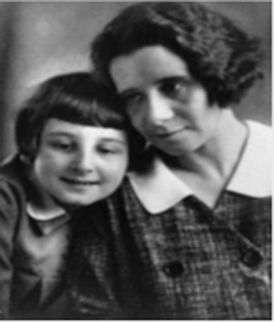
Marte and Alice, Germany, 1931, Die Deutsche Bibliothek, Deutsches Exilarchiv 1933-1945
Alice Brill’s parents were intellectuals – her Mother Marte was a journalist, daughter of petit-bourgeois and the Father, Erich Brill, was a painter, born in a family of merchants from the upper middle class, who did not approve of the couple’s relationship. Both came from Jewish families. Moreover, as Alice wrote about her Father, “a born artist, bohemian out of conviction, was definitely not cut out for a common middle class life” (apud Alarcon, 2007: 34)
Alice Brill, in her testimonial for the work of Daniela
Alarcon, Diário Íntimo - a fotografia de Alice Brill (2007:
26), remarks “it is understandable that Wolf Brill did not accept his
daughter in law (at the time) who was from an intellectual family, however
poor, not able to provide a dowry for the wedding”. Marte became pregnant
and had her daughter Alice, but the marriage fell apart the following
year, as Erich was a ‘bon femme’.
Marte, who had also been a writer, wrote in her book Der Schmeltztiegel,
(The Crucible) , not published in Portuguese, only in German, in 2003,
a poem she called Meteor, referring to her brief marriage to Erich:
“When the leaves of youthful sap, / still unfolding in growth and decorating
themselves with flowers / fall on the ground beneath the touch of Autumn/
I will be alone (...).”
However, the couple kept a close and intellectual relationship throughout their lives. Erich and Marte, although they did not practice Judaism and nor transmit a religious education to Alice had ties with their background and expressed interest in its history and culture. German Jews only obtained equality of civil rights at the end of the 19th century. Although there were legal guarantees in the 1860 Constitution, social equality was only achieved in the Weimar Republic, the period in which anti-Semitism was intensified again.
Alice was born in Cologne, in 1920, however grew up in Hamburg, where her parents lived. Marte and Alice lived in a Residential Complex in the outskirts of the city, where public employees, workers and people who were part of the minor bourgeois also lived. The city of Hamburg was an international Port, which generated dynamism to urban life and a cosmopolitan aspect, as it was an economic centre, as well as cultural exchange. The Port is set up as an economic pole associated to navigation, but also reveals local identity. In her book, Marte defined the city as a ‘portal to the world.
Although the period of great wealth in the city had occurred before the 16th century, in the beginning of the 20th century, Cologne and Hamburg were still characterized as economically and culturally important cities. In 1924, Germany already gave signs of social-economic improvement, as the industry had been modernized, salaries were increasing and the unemployment rate had gone down (Alarcon, 2007:27).
However, recovery, did not present a solid foundation. Although Western Europe had been through an economic development phase, after the end of the war, the 1929 crisis had already begun.Eric Hobsbawn, in Age of Extremes (2001:95), remarks that “the effects of the New York Stock Exchange collapse were disastrous for Germany. The whole castle of repair cards fell apart during the Depression. Exports plummeted and foreign loans were not renewed; currency depreciation led to high prices and, consequently worsening of poverty.”
In the following year, there was little left of the Treaty of Versailles, as the German State was militarized and the population was attracted by the ideological discourse of the emerging Nazi Party that managed to expand rapidly. In parallel to the strained political and economic profile in Germany, the Weimar culture manifests a fleeting climax, as there was much artistic and intellectual expression in a short-lived and flimsy period. However, according to Gisele Freund (1986), even though it was a brief Republic, there was masterful innovation of the arts.
In this bleak scenario, Alice was a girl in development. Daniela Alarcon (2007: 32) highlights that the concepts developed in the schools and art trends, during the 1920s and 1930s - “the integration between the arts, the abolition of dichotomy between art and technique, the new visuality, collective creation and emphasis on the insertion of the artist in society - influenced Alice as a visual artist, a photographer and theoretical reference.” The same can be said with regard to Hildegard Baum, our other female artist, being studied, who lived in a similar context.
Commenting on her childhood, in the introduction of her book Art and Language (1988:11), Alice states:
“Since I was a little girl I had an impulse towards creativity, self-expression, was present in my life, manifesting itself in different ways. I liked to draw, write and do everything that depends on imagination”.
Expressionism, Bauhaus, the New Vision, the New Objectivity and German photojournalism constitute the creative background of the environment where these two German girls lived - Alice Brill, and also Hildegard Baum – where subsequently their photographs bring to light aspects of this experience, in their view and photographic work, in Brazil.
When Alice left her school, which had a modernizing profile, on account of Nazi threats, in 1931, her Father Erich Brill “gave her a notebook with a full-colour cover, and wrote the following in the dedication: ‘my dear bunny, my dearest daughter, write whatever you want in this book: thoughts and stories you make up” (Alarcon, 2007:31). In this notebook and others, Alice wrote stories, her lessons and also verses. I highlight this gift given by Erich Brill to Alice, in her childhood, to show how she was encouraged by her parents to express herself and her creativity, since she was a little girl.
In 1933, the rise of Nazism created a rupture in German cultural production. It was not only the rising of Hitler to power, but also the closing of Bauhaus and the crushing of “degenerate” art and banishment of artists, thinkers and political activists.
As written by Peter Gay (1978), with the exiled that left Germany, the Weimar culture that had intrinsic internationalism managed to be spread to other countries conducting critical artistic manifestations. For this author, “the culture of Weimar shared the experience developed in other European countries”. (1978: 19)
With the rising of Nazi power anti-Semitism spread in Germany, as an integral part of Nazi ideology, based on a biological racist bias, which defended the concept of superiority of the Aryan man, as stated by Peter Gay. Ethos was added to these concepts, influenced by Nazi advertising saying that the Jews were responsible for Germany’s economic crisis.
Due to the situation, of social and economic exclusion of the Jews described, Marte was dismissed from the radio in Hamburg and, in March 1933, goes with Alice to the Spanish Island of Majorca.
In her book Der Schmeltztiegel (The Crucible), Marte personified in the book as Sylvia, remarks in distress “the child had lost everything, more than the adults, more than a mature person could understand. However, she still didn’t know that she had lost her native country forever.” (s.d.:32)
Erich gave Alice a photographic camera as a gift for her trip - a small and simple Bela Box, that took 3x4 pictures. The images of places of exile such as Madeira Islands, in Portugal, in Tétouan and Casablanca, in Morocco, in Alcúdia and Majorca, on the Spanish coast, in Holland and also in Rio de Janeiro and São Paulo – are visual witnesses of these childhood memories. Alice Brill has a collection of over 200 pictures in a small leather album, that contains the record of the time between leaving Germany and being received in Brazil.
In Majorca, Alice already showed a sensitive eye, “observing everything, from the smallest insect to human behaviour, as noted by her Mother in Der Schmeltztiegel (The Crucible, s.d.).Later, after having stayed in Majorca, more than a year, both looked for a better haven in Italy, however they would not stay long due to the adverse conditions there, with the rise of Fascism.
With the worsening fierceness of the Nazi regime in Germany, Marte was lucky to receive a letter from the chief-editor of the magazine Hamburg-Sud, she had worked in back in Germany, offering two tickets to Brazil, the second most common destination in South America to all exiled German Jews, after Argentina.Marte went to Brazil first to prepare for Alice’s arrival, in 1933. Alice continued to live with her Father, for another year in Holland.
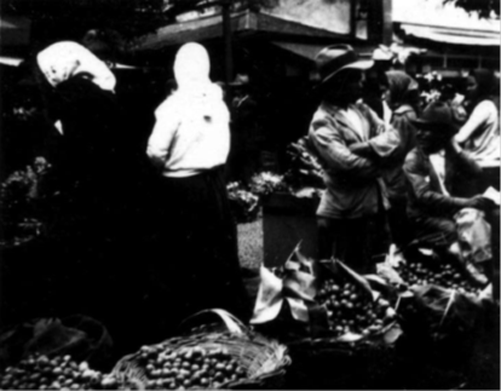
Alice Brill, Spanish market, 1933, reproduction Daniela Alarcon, copyright Alice Brill Collection
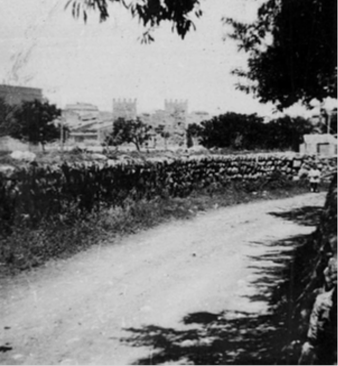
Alice Brill, Alcudia, 1933, reproduction Daniela Alarcon, copyright Alice Brill Collection
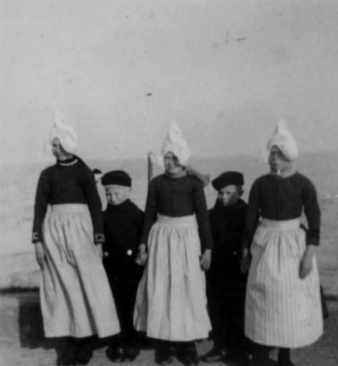
Alice Brill, Children, Holland, 1934, reproduction Daniela Alarcon, copyright Alice Brill collection
In the three images edited above – some records of the exile – we see pictures of places in Spain where Alice and Marte stopped at, before reaching their destination – the Island of Majorca.
In the market picture we notice the attention given to details and minutiae in the locations they stopped at for a visit. Although the image of the market, does not have a lot of contrast or sharpness, we see a blatant record of daily routine, in its movement, concentrated observation of the arrangement of the people’s bodies there – the man, in front of the stacked vegetables, in bags, as well as the women, with their typical scarves, used in Spain at the time. A few decades later, in pictures of Alice in the city of São Paulo, also in those of markets and fairs, we will find a similar look in a permanent documentary record of notorious everyday life.
The picture of Alcúdia, 1933, apparently, calls Alice’s attention to the wall and a stone construction, with towers, material widely used in local architecture, at the time. This work, thus respectively composes, the foreground with the dirt road and the child on the right, in the background – different views outlined by her.
On the other hand, the picture of the children, in Holland, appears to have been assembled, due to its symmetry – i.e., we see three ladies, with the same typically female clothes and hats used in that country in the past, in the midst of two boys, practically of the same height and with similar clothes, in a street /on a stone walkway, in front of the sea. Furthermore, both boys are holding the girls’ hands, in their midst, as if the girls were protecting them.
It is interesting to note that the girls’ demeanours provide anonymity and homogeneity to the picture, as their looks and expressions are practically hidden beneath the hats, plus the fact that the boys and girls are wearing the same clothing. The impression perceived in the picture, “a kind of overview of this country”, as all the characters appear in traditional costumes, by the sea, which is another significant indicator of this place. Besides, the foreground of the picture registers an extended shadow - Alice Brill and her photographic camera.
In exile in Brazil, the abode
Having as a framework the principles presented in this article - such as the family, educational and cultural background, the place of exile and the social drama experienced by Hildegard Baum and Alice Brill, in Europe – the arrival and entry into Brazil conducting the two young females to another moment, in exile, in the new country, and, more specifically in their insertion, as female artists and photographers, in São Paulo, as from the mid-1930s.
Both artists managed to conquer their working space as female photographers, in the metropolitan area of São Paulo, in spite of the difficulties at the time of accepting female work, at news agencies, the Art Museum of São Paulo, generating portraits of artists from that time and registering families from their milieu. They did their personal photo shoots and inserted themselves in the city’s artistic circuit.
Hildegard Rosenthal and Alice Brill are seen as pioneers as they did photo shoots in public spaces, mainly on the streets, their form of occupation and how São Paulo residents use them and also other cities in Brazil, and because they are photojournalists, present a modern and humanist view in this artistic expression. As a counterpoint, the photographic studios, directed by women in the 1920s and 1930s, which existed in São Paulo, did mainly pictures of adults and children and graduation albums in closed environments.
Both generated their photographic production, creating collections of images, mainly in the 40s and 50s, ceasing to act professionally in the photographic area, during this last period. The rediscovery of their image collections and their recognition as artists, occurred only in the mid-70s, with several exhibitions in the city and the donation of part of their work to the Museum of Contemporary Art from the University of São Paulo and the acquisition of Hildegard Rosenthal’s collections by the Moreira Salles Institute, respectively, in 1996, and Alice Brill’s, in 2000. It is important to emphasize that both female artists not only created a relevant documentary collection but their production also exposes their signature.
Biography
Yara Schreiber Dines, Master and Doctor in Social Anthropology, Post-doctorate in Photography, at the University of São Paulo. Substitute Professor at Unesp Franca, Associate Researcher of the Sound and Image Anthropology Laboratory - LISA/USP and the Contemporary Anthropology Study Group - GEPAC/Araraquara. Author of the book Cidadelas da Cultura no Lazer – uma reflexão em antropologia da Imagem sobre o Sesc São Paulo (São Paulo, Sesc São Paulo, 2013) and several articles. Curator of photographic exhibitions.
Email: yara_schreiber@uol.com.br
BIBLIOGRAPHY
Books
Achutti, Luiz Eduardo Robinson. 1997. Fotoetnografia. Um estudo de antropologia visual sobre cotidiano, lixo e trabalho. Porto Alegre: Tomo Editorial, CXXV, 93p.
Alarcon, Daniela. 1998. Diário Íntimo - a fotografia de Alice Brill. São Paulo: Trabalho de Conclusão de Curso, ECA/USP.
Andress, Richard. 2005. The German Exile Experience in Brazil from the Perspective of Arnold van Gennep´s Les rite de passage. EVELEIN, Johannes F. Exiles Traveling. Exploring Displacement, Crossing Boundaries in German Exile Arts and Writings 1933-1945. Amsterdam: Edition Rodopi B. V., New York.
Aumont, J. 1993. A imagem. Campinas: Papirus.
Barbosa, Andréa e Cunha, Edgar Teodoro da. 2006. Antropologia e Imagem. Rio de Janeiro: Jorge Zahar Editor.
Barthes, Roland. 1981. A Câmara Clara. Lisboa: Edições 70.
BOLETIM_3 Grupo de Estudos Artes&Fotografia. 2009. São Paulo: Departamento de Artes Plásticas da Escola de Comunicação e Artes da Universidade de São Paulo, maio.
BOLETIM_4 Grupo de Estudos Artes&Fotografia. 2012. São Paulo: Departamento de Artes Plásticas da Escola de Comunicação e Artes da Universidade de São Paulo.
Brill, Alice. Da arte e da linguagem. 1988. São Paulo: Editora Perspectiva.
Brill, Marte. 2003. Der Schmeltztiegel. Frankfurt e Main. Mit einem Nachwort von Reinhard Andress. Edition Büchergilde.
Caiuby Novaes, Sylvia, Eckert, Cornelia, Martins, José de Souza (orgs.) 2005. O imaginário e o poético nas Ciências Sociais. Bauru: Edusc.
Caiuby Novaes, Sylvia (coord.). junho 1998. Imagem em foco nas ciências sociais. Projeto temático apresentado à FAPESP.
______________________. 1993. Jogo de espelhos: imagens da representação de si através dos outros. São Paulo: Edusp.
Canevacci, Massimo. 1993. A Cidade Polifônica - ensaio sobre a Antropologia da Comunicação Urbana. São Paulo: Studio Nobel.
Chiarelli, Tadeu. 2010. Descarimbando as figurinhas: objetividade e subjetividade na relação fotográfica/documento: o caso Gilda Mattar. São Paulo: DBA.
________________. 2004. “Algumas palavras sobre a obra de Mick Carnicelli. Mick Carnicelli. São Paulo paisagem da alma. São Paulo: Momesso Edições e Museu de Arte Moderna de São Paulo.
Duby, Georges, Perrot, Michelle (org). 1999. História das Mulheres. Porto: Afrontamento, vol. 1 a 5.
Duby, Georges, Perrot, Michele. 1992. Imagem da Mulher. Porto: Afrontamento.
Dubois, Philipe. 1992. O ato fotográfico e outros ensaios. Campinas: Papirus.
Dupeaux, Louis. 1992. História Cultural da Alemanha. Editora Civilização Brasileira.
Edwards, Elizabeth. 1992. Antropologia e Fotografia. s.d. Cadernos de Antropologia e Imagem 2. Rio de Janeiro: UERJ, NAI.
Edwards, Elizabeth. 1992. <<Introduction>>.(ed.). Anthropology & photography, 1860-1920. New Haven/London: Yale University Press/ The Royal Antropological Institute, p. 3-17.
Elias, Norbert. 1997. Os Alemães. A luta pelo poder e a evolução do habitus nos séculos XIX e XX. Rio de Janeiro: Editora Zahar.
Fernandes, Eva Lieblich. 2005. A arte como verdadeira vida. O mundo de Alice Brill. São Paulo: Instituto Moreira Salles.
Freund, Gisele. 1986. La fotografía como documento social. Barcelona: Gustavo
Gili.
Flusser, Vilém. 2011. Filosofia da caixa preta: ensaios para uma futura filosofia da fotografia. São Paulo: Annablume.
Geertz, Clifford. 2001. Nova Luz sobre a Antropologia. Rio de Janeiro: Jorge Zahar Editor.
Gay Peter. 1978. A Cultura de Weimar. Paz e Terra.
Gonçalves, Paula Chrystina Scarpin. 2007. Vale das Rosas - Hildegard Rosenthal - pioneira da fotografia do Brasil. São Paulo: Trabalho de Conclusão de Curso, ECA/USP.
Hacking, Juliet (coord.). 2012. Tudo sobre Fotografia. Rio de Janeiro: Sextante.
Hobsbawn, Eric. 1995. A Era dos Extremos. O breve século XX. Companhia das Letras.
Huberman-Didi. Georges. Ante del Tiempo. 2006. Buenos Aires, Adriana Hidalgo Editora.
Kossoy, Boris. 2004. Luzes e sombra da metrópole: um século de fotografias em São Paulo (1850-1950). PORTA, Paula. História da Cidade de São Paulo. A cidade no Império 1823-1889. São Paulo: Editora Paz e Terra S. A, p. 387-455.
Lévi-Strauss, Claude. 1997. Olhar, Escutar, Ler. São Paulo: Companhia das Letras.
Lionel, Richard. 1993. Berlim 1919-1933. Rio de Janeiro: Editora Zahar.
----------------------. 1988. A república de Weimar (1919-1933). São Paulo: Cia das Letras.
Lugon, Olivier. 2001. Le style documentaire. D´August Sander à Walker Evans 1920-1945. Paris: Macula.
Mariano, Silvana Aparecida. set.-dez./2005. <<O sujeito do feminismo e o pós-estruturalismo>>. Estudos Feministas. Florianópolis: 13(3): 320.
Peirano, Mariza. 2003. Rituais ontem e hoje. Rio de Janeiro: Jorge Zahar Editores.
Oliveira, Maria Luiza. 2010. Metrópole Hildegard Rosenthal. São Paulo: Instituto Moreira Salles.
Sontag, Susan; Figueiredo, Rubens. 2004. Sobre Fotografia. São Paulo: Companhia das Letras.
Strauss, Dieter. 1996. Prefácio, O Eterno Exílio. Brasil - um Refúgio nos Trópicos. São Paulo: Estação Liberdade.
Turner, V. 1974. Dramas, Fields and Metaphors: symbolic action in Human Society. Ithaca: Cornell University Press.
Catalog
Hildegard Rosenthal. 1997. Cenas Urbanas. Catálogo do IMS. São Paulo: Instituto Moreira Salles.
O mundo de Alice Brill. 2005. Catálogo. São Paulo: Instituto Moreira Salles.
Toledo, Benedito Lima de. 1997. Um Olhar Encantado pelos tipos humanos. Hildegard Rosenthal. Cenas Urbanas (Catálogo). São Paulo: Instituto Moreira Salles.
Sites
Die Deutsche Bibliothek, Deutsches Exilarchiv, 1933-1945
(http://www.d-nb.de/sammlungen/dea/bestaende/archivalien/exil_
nachlaesse.htm). Consultado em 2013.
http://mobiletest.moma.org/explore/collection/object/50674.iphone?moma_url_type=int&moma_title=Grete's%20Eyes#object_50674. Consultado em 2013.
http://calgainesphotography.com/tag/laszlo-moholy-nagy/. Consultado em 2013.
http://www.moma.org/collection/browse_results.php?criteria=O%3AAD%3AE%3A869&page_number&template_id=6&sort_order=1. Consultado em 2013.
http://cargocollective.com/krupnickkrupnick/August-Sander-People-of-the-20th-Century. Consultado em 2013.
http://www.alistairscott.com/patzsch/. Consultado em 2013.
Testimony
Juvenal Pereira, agosto 2013
Silvia Czapski, junho 2013
[1] Didi-Huberman, in Ante el tiempo (2008), creates a relation between the sense of awakening and the child, as from Benjamin’s ideas about the child and the game. In this sense, the use of this notion sounds very rich to understand education and the influences that both artists, being studied, had in Germany. As stated by Huberman, “Benjamin, ... is the bearer of ‘childlike energy’ that refers to the game, to the movements made by the children when playing it. The action of the child, besides rotating, telling, whimsically classifying the ‘rags’, also sleeping on them and waking up after having dreamed. In this intersection produced between sleeping and waking – ‘the bifacial instant of wakening’, proposes Didi-Huberman – is built for Benjamin, knowledge.” (DIDI-HUBERMAN, 2006:21) (author’s translation). Furthermore, says Didi-Huberman, Benjamin on resuming the text ‘Moral del Juguete’ (1853), by Charles Baudelaire, points out ‘dialectic powers’ of the game – an unrelenting mixture of elements that counteract each other, through which we can notice a “child’s first initiation in art’ as well as the instance of knowledge.” (dito, p. 22)
[2] Therefore, it seems that the aunts hid Hildegard in a wardrobe during a few months, so the paternal grandfather wouldn’t know about the child. The grandfather discovers the story and becomes very happy. The structure of this story is similar to that of a myth, as Hildegard Baum had ‘stayed in a hidden camera’, according to photographer Juvenal Pereira, inside a wardrobe, only seeing drawn shadows – a “projected destiny”.
[3] . GONÇALVES, Paula Chrystina Scarpin. Vale das Rosas. Hildegard Rosenthal – pioneer of photography in Brazil. São Paulo, Course conclusion paper, ECA/USP, 2007:21
[4]. I had access to a Portuguese version of the book, written by Inês Czapski Dellape, daughter of Alice Brill. In this book, Marte narrates, through fictitious characters, the passages, misfortunes and experiences she had together with Alice, during the period in exile in Europe and settling down in Brazil.
.
